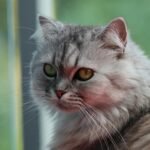Cats are often seen as independent creatures who thrive on their own terms. Yet, beneath that aloof exterior, there are breeds that crave the warmth and presence of their human family. Cats, much like people, can feel lonely and even fall into depression when they are excluded from the family dynamic. Understanding these breeds can help cat lovers ensure their furry friends remain happy and mentally healthy.
Ragdoll: The Gentle Giant
Ragdolls are known for their large size and striking blue eyes, but their true charm lies in their affectionate nature. These gentle giants are highly sociable and thrive on human interaction. When left alone for extended periods, Ragdolls may become withdrawn and lethargic. They have a tendency to follow their owners around the house like shadows, seeking constant companionship. It’s essential for owners to engage with them frequently, offering not just physical presence but also emotional engagement. Interactive play sessions can provide mental stimulation and strengthen that all-important bond. Envision a Ragdoll as a loving teddy bear that needs to be hugged and included in your daily life.
Sphynx: The Velcro Cat
The Sphynx cat, often recognized for its lack of fur and wrinkled skin, is a breed that wears its heart on its sleeve. Often referred to as the “Velcro cat,” these felines are known for their clingy nature. They form deep bonds with their families and can become visibly distressed when left out. The absence of fur means they seek warmth, both physically and emotionally, often curling up with their humans. Owners of Sphynx cats should make a point to involve them in family activities and allow them to be part of daily routines. Their social nature means they thrive in environments where they feel like an integral member of the family.
Siamese: The Vocal Companion
Siamese cats are famous for their striking appearance and vocal nature. They are not just pretty faces; they are also deeply emotional creatures who communicate their needs clearly. A Siamese cat left out of the family dynamic may become excessively vocal, expressing its distress through loud meows. Their intelligence and curiosity mean they require mental stimulation and companionship to stay happy. Engaging them in interactive play or simply talking to them can make a world of difference. Consider a Siamese as a conversational partner who needs to be heard and understood.
Scottish Fold: The Gentle Observer
The Scottish Fold, with its unique folded ears and round face, is a breed that loves to be in the center of family life. These cats are gentle and affectionate, often preferring to observe and participate from a safe distance. When excluded, they may become sullen and withdrawn, showing less interest in their surroundings. It’s crucial to involve them in everyday activities, ensuring they feel part of the family’s ebb and flow. They may not demand attention like other breeds, but their quiet presence is a sign of their deep-seated need for inclusion.
Maine Coon: The Social Butterfly
Known as the gentle giants of the cat world, Maine Coons are highly sociable and enjoy being part of the family. Their dog-like loyalty means they often follow family members from room to room. When left out, these affectionate cats can become depressed, showing signs of anxiety and restlessness. They require a stimulating environment and regular interaction to stay content. Owners can keep Maine Coons happy by involving them in interactive games and ensuring they have plenty of opportunities to socialize. Think of them as the life of the party who needs to be in the mix to feel alive.
Birman: The Sweet-Natured Companion
Birmans, with their striking blue eyes and soft demeanor, are sweet-natured and affectionate. They form close bonds with their families and can become despondent when ignored. These cats thrive on attention and are happiest when they feel included in family activities. Owners should make an effort to involve them in daily routines, offering plenty of affection and playtime. Birmans are like the gentle friends who value emotional connections and need reassurance of their place in the family.
Oriental Shorthair: The Curious Explorer
Oriental Shorthairs are known for their sleek appearance and inquisitive nature. These cats are highly intelligent and thrive on interaction and engagement. When left out of the family dynamic, they may become bored and display destructive behavior. Their curiosity means they love exploring and being part of the action. Providing them with toys and puzzles can help keep their minds active, while ensuring they are included in family activities will keep them content. They are like the curious explorers who need to be part of every adventure.
Devon Rex: The Playful Pixie
The Devon Rex, with its elfin features and playful nature, is a breed that thrives on interaction. These cats form strong bonds with their families and can become distressed when excluded. Their playful demeanor means they require regular stimulation and involvement in family activities to stay happy. Owners can keep Devon Rexes content by offering interactive toys and ensuring they are part of the family’s daily life. Think of them as the playful pixies who bring joy and energy to any household.
Tonkinese: The People-Oriented Feline
Tonkinese cats are known for their social nature and people-oriented personality. They form deep bonds with their families and can become depressed when left out. These cats thrive on attention and need to feel included in family activities. Regular interaction and engagement are essential to keep them happy. Owners can keep Tonkinese cats content by involving them in playtime and providing plenty of affection. They are like the social butterflies who need to be part of the crowd to feel content.
Burmese: The Affectionate Shadow
Burmese cats are known for their affectionate nature and love of human companionship. These cats form strong bonds with their families and can become distressed when left out. Their affectionate nature means they thrive on attention and need to feel included in family activities. Regular interaction and engagement are essential to keep them happy. Owners can keep Burmese cats content by involving them in playtime and providing plenty of affection. Think of them as the affectionate shadows who need to be close to their humans to feel secure.
Understanding the unique needs of these cat breeds can help cat owners create a nurturing environment where their feline friends feel loved and included. Each of these breeds has its own personality and requires different levels of interaction and engagement to avoid feelings of depression. By acknowledging these needs, cat lovers can ensure their pets lead happy and fulfilling lives.

Growing up traveling and experiencing new cultures and wonders, I have had a passion for nature, adventuring, photography, and videography. I am currently working towards a BSc in Biodiversity and Ecology at Stellenbosch University, and I hope to specialise in Marine Sciences one day.
Please send any feedback to Feedback@animalsaroundtheglobe.com






